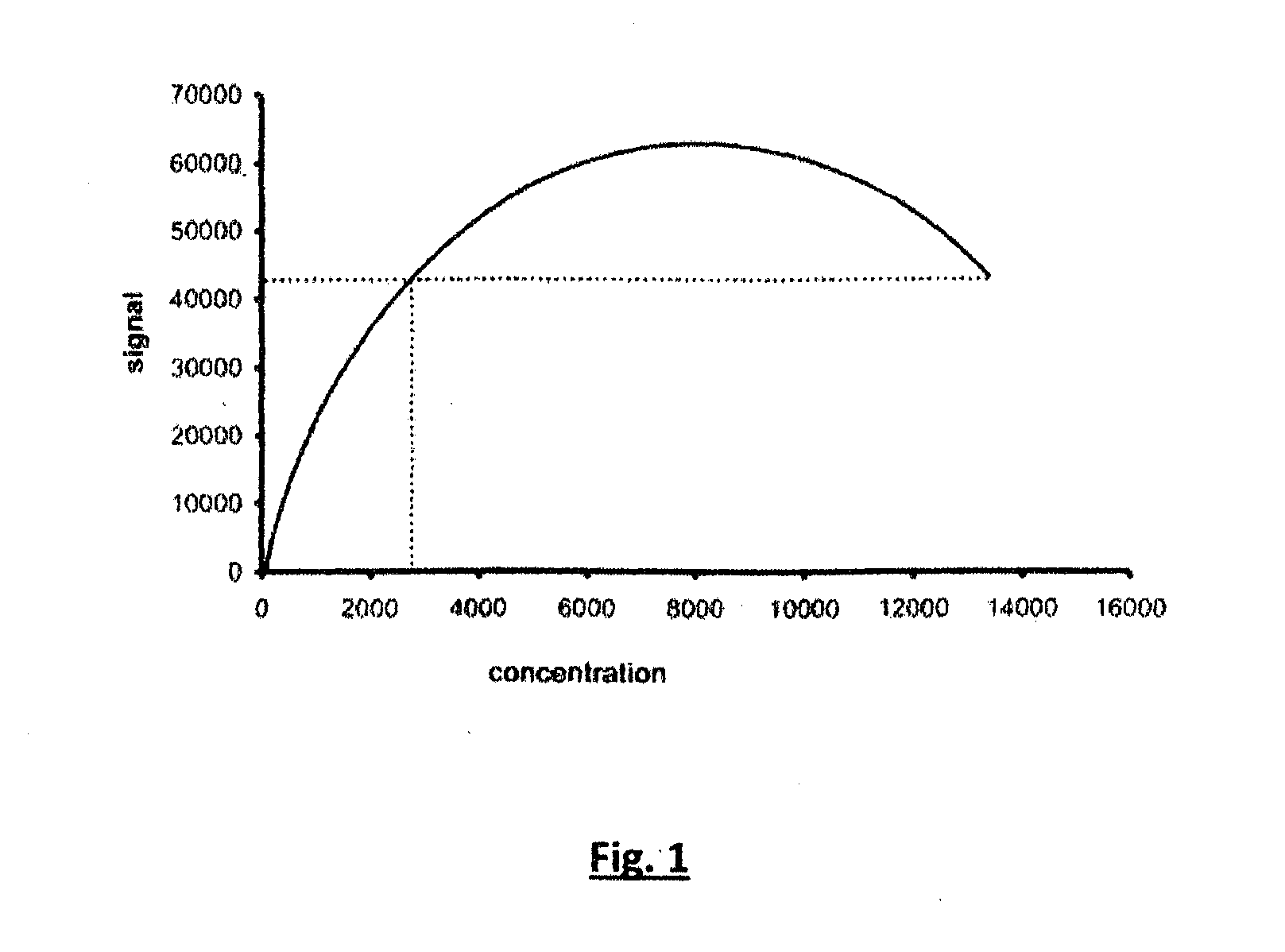Homogeneous competitive lateral flow assay
a lateral flow assay and homogeneous technology, applied in the field of homogeneous competitive lateral flow assay, can solve the problems of compromising the specificity and sensitivity of immunoassay, prone to immunoassay, and at best serious underestimate of target analyte present at a high concentration, so as to eliminate false negative results, enhance the immediacy of results, and facilitate rapid and easy use.
- Summary
- Abstract
- Description
- Claims
- Application Information
AI Technical Summary
Benefits of technology
Problems solved by technology
Method used
Image
Examples
example 1
[0094]The presence of a hook effect in LFA's of the prior art and the elimination of the hook effect using an LFA in accordance with the invention employing SAA as an analyte was demonstrated as follows.
[0095]The hook effect was demonstrated in the analysis of SAA employing a sandwich assay using standard lateral flow technology test format well known to those skilled in the art. While variations in test assembly are known the example given is descriptive of typical analytical approaches adopted in the prior art.
[0096]Test strips were prepared as follows:
[0097]Antibody-gold nanoparticle conjugates were prepared using typical known methods as referenced in Conjugation of colloidal gold to proteins, Methods in Mol Biol, 2010, 588, 369-373. Briefly, 1 ml of gold nanoparticles (40 nm gold particles, BBI, Cardiff, UK) were coated with 100 μl monoclonal antibody to SAA at 0.5 mg / ml and incubated for 1 hour at room temperature. Unbound antibody was removed by centrifugation at 2500 rpm. Th...
example 2
[0114]The presence of a hook effect in lateral flow tests using whole blood samples with SAA as an analyte was demonstrated as follows.
[0115]Membranes with three test lines were prepared as indicated in Example 1. Samples with SAA at <5 μg / ml, 39 μg / ml, 188 μg / ml and greater than 500 μg / ml as determined by the laboratory method described in Example 1 were investigated. The test was run using 10 μl of sample added to test strips followed by 100 μl of PBS, pH 7.2. Tests were read visually after 10 minutes. No signal was seen at samples less than 5 μg / ml SAA or with SAA samples at 188 μg / ml or greater 500 μg / ml of SAA although a signal was observed when using the sample at 39 μg / ml clearly indicating the presence of a hook effect with whole blood samples.
[0116]The analysis of the samples was repeated with LFA test strips in accordance with the invention as described in Example 1. 10 μl of sample was added to the sample port followed by 100 μl of PBS buffer. Three test lines were observ...
example 3
[0117]The use of the assay of the invention in the analysis of SAA in equine blood samples to determine the inflammatory status of the horse for diagnostic purposes was demonstrated as follows.
[0118]For rapid test analysis, whole blood analyses were performed with test strips with three Test Lines 1,2,3 as described in Example 1. 10 μl of whole blood was applied directly onto the test strip via the sample application port on the cassette followed by 100 μl of PBS buffer. After 10-15 minutes results were observed and interpreted as “Normal” (three Test Lines 1,2,3 and Control Line 4 visible), “Mild Inflammation” (two Test Lines 2,3 and Control Line 4 visible), “Moderate Inflammation” (one Test Line 3 and Control Line 4 visible) and “Severe Inflammation” (Control Line 4 only visible).
[0119]Corresponding serum samples from each blood sample were also analyzed using a commercially available a laboratory based system to establish SAA levels. SAA concentrations were determined using a hum...
PUM
| Property | Measurement | Unit |
|---|---|---|
| concentration | aaaaa | aaaaa |
| volume | aaaaa | aaaaa |
| pH | aaaaa | aaaaa |
Abstract
Description
Claims
Application Information
 Login to View More
Login to View More - R&D
- Intellectual Property
- Life Sciences
- Materials
- Tech Scout
- Unparalleled Data Quality
- Higher Quality Content
- 60% Fewer Hallucinations
Browse by: Latest US Patents, China's latest patents, Technical Efficacy Thesaurus, Application Domain, Technology Topic, Popular Technical Reports.
© 2025 PatSnap. All rights reserved.Legal|Privacy policy|Modern Slavery Act Transparency Statement|Sitemap|About US| Contact US: help@patsnap.com


